The relationships between the achievement motivations and temperaments of psychology students with different lateral organization profiles
Abstract
The objective of this research was to assess the motivational potential of psychology students using an egoskopiya method. Heart rate and EEG data were recorded while the participants performed the Mehrabian achievement motivation test. Thirty students of the Faculty of Psychology of Southern Federal University who were aged between 20 and 30 years participated. The psychodiagnostic study involved 136 students from the Faculty of Psychology of Southern Federal University who were aged between 18 and 49 years. To determine the lateral organization profiles of sensory and motor functions, a computer-based testing program termed “Profile” was used. The Compact Russian Structure of Temperament Questionnaire (STQ-77) was used to evaluate the features of temperament.
The results revealed that people with a strong motivation to succeed exhibited a predominance of right features in their lateral organization profiles. Their cardiovascular systems were in more activated states than those of the people who were extremely motivated to avoid failure. The observed temperament features of psychology students with different levels of achievement motivation indicated that the level of achievement motivation is related to the properties of temperament such that students with lower levels of achievement motivation (i.e., motivation to avoid failure) exhibited the temperament traits of Neuroticism and Impulsivity in addition to low values on the scales for the Sensitivity to Sensations, Intellectual Ergonicity, and Sensitivity to Probabilities. High levels of achievement motivation (i.e., motivation to strive toward success) corresponded to the psychology students’ propensities for Sensitivity to Sensations, high levels of Intellectual Ergonicity, high levels of Sensitivity to Probabilities and low values on the scales of Impulsivity and Neuroticism.
Received: 10.10.2014
Accepted: 13.01.2015
Themes: Cognitive psychology; Personality psychology
PDF: http://psychologyinrussia.com/volumes/pdf/2015_1/2015_1_32-42.pdf
Pages: 32-42
DOI: 10.11621/pir.2015.0104
Keywords: individual profile asymmetry, achievement motivation, temperament, egoskopiya.
Introduction
Motivation is often a determinant that defines efficiency. Time spent as a student is a period of intense development of the motivational sphere and professional skills. The effectiveness of the educational process in higher education is directly related to the level of motivation of the students toward the training in their chosen profession. Achievement motivation occupies an important place in the structure of the motivational sphere of the future expert. We have previously used the twin method to show that achievement motivation is closely related to general, verbal and non- verbal intelligence and the subject of both environmental and hereditary influences (Vorobyeva & Popova, 2009). There are electroencephalographic features that are associated with the manifestations of the motivation to avoid failure and the desire to succeed (Ermakov et al., 2011, Vorobyeva et al., 2012). Studies of achievement motivation have made it possible to estimate the real socio-environmental opportunities for its formation and development. Further work in this regard will involve research assessing the relationships between achievement motivation and the peculiarities of individual profile asymmetries and temperament traits.
Individual profile asymmetry is manifested as a set of motor, sensory, and cognitive asymmetries that are specific to an individual. The reasons for the differences in individual profiles of asymmetry are actively being investigated, and it has been shown that the greatest contribution to the differences in manual asymmetry include the contributing factors of the shared environment Furthermore, the contribution of genetic factors increases with increases in respondent age (Vuoksimaa et al., 2009; Medland et al., 2009; Teixeira, 2008). Among the reasons for the lateralization of motor functions, hereditary (i.e., genetic causes) and cultural-environmental (i.e., belonging to a certain population) causes stand out (Sommer et al., 2008). The latter influences are well known and are manifested at different frequencies in different types of lateral organization profiles of sensorimotor functions in different populations. In this regard, we performed a study that assessed the contributions of genetic and environmental factors to the manifestation of individual profiles of asymmetry in a South-Russian sample (Ermakov et al., 2010; Vorobyeva, 2012).
Features of temperament and the individual-typological features underlying them can be considered to be important foundations of individual differences that provide individual generations with individual styles of both professional and educational activity (Ilyin, 2001). V.M. Rusalov et al. identified the physiological characteristics of students with who had chosen different professions and found that the most important indicator of temperament was endurance (Rusalov, Rusa- lova & Strelnikova, 2004). In recent years, cross-cultural studies have shown the effectiveness of the model of temperament that underlies the Structure of Tem-perament Questionnaire STQ-77E in the forecasting of success based on various types of mental activity (i.e., intellectual, social, verbal, and “mixed”) (Rusalov & Trofimova, 2011).
Applied methods of behavioral genetics have revealed significant genetic conditioning and inter-individual differences in the characteristics of temperament. Thus, J.O. Novgorodova assessed the contributions of genetic and environmental factors to the variability of the features of temperament in primary school children. To assess temperament, this author used the parent version of the questionnaire that was also used by Rothbart. The sample consisted of 85 pairs of twins aged 7 to 10 years of which 49 pairs of twins were monozygotic and 36 pairs were same- sex dizygotic twins. The highest estimates of the contributions of genotype were obtained for indicators that included fear, braking control, shyness and depressed mood (Novgorodova et al., 2010). Another study that involved monozygotic and dizygotic twins aged 12–14 years that employed the Structure of Temperament Questionnaire revealed that genetic determination was highest in terms of social tempo and objective and social emotional sensitivity (Malykh et al., 2009).
Previously, we sought to define the contributions of genetic and environmental components to phenotypic variation in temperament and the genetic correlations between temperament and achievement motivation. here, we sought to assess the degrees of temperament features using the Structure of Temperament Questionnaire. This study involved 16 pairs of same-sex dizygotic twins aged from 10 to 19 years and 27 pairs of monozygotic twins aged from 8 to 27 years. For the structure of temperament questionnaire, the highest heritability is set to a scale such as endurance. The hereditarily determined phenotypic variations in plasticity, social tempo emotion, and social emotion are also revealed. It was found that the degree of achievement motivation was directly proportional to the levels of endurance, social endurance, plasticity, tempo, and social tempo and inversely associated with emotional and social emotional (Vorobyeva, 2006).
The purpose of this study was to examine the motivational features of psychology students of the Faculty of Psychology of the Southern Federal University (Rostov-on-Don) with different lateral organization profiles in combination with the recording of electrophysiological parameters.
Method
Participants
This work was performed in two stages and involved two samples. The research objective was to assess the motivational potential of psychology students via the egoskopiya method. The participants’ heart rate and EEG data were recorded while they performed the Mehrabian achievement motivation test. The individual asymmetry profiles of the participants were assessed using the “Profile” computer pro- gram. Thirty students of the Faculty of Psychology of Southern Federal University with ages from 20 to 30 years (17 women, 13 men) participated. All examinees were free of neurologic, mental and somatic disorders, and all participants had previously been acquainted with and agreed to the research procedure. The psychodiagnostic study involved 136 students of the Faculty of Psychology of Southern Federal University aged from 18 to 49 years (113 women and 23 men).
Instruments
The egoskopiya method consists of the simultaneous application of psychometric tests and the recording of various physiological signals to allow for the objectification of the acquired data (Yuriev & Skomorokhov, 2007).
Egoskop (Medicom, Russia) is intended for the automated performance of pilot studies of personality via psychodiagnostic techniques that employ the synchronous registration of physiological signals. The EEG recording during the egoskop inspection in our work was performed with electrodes in the Fz, Pz and the ear reviewer positions and conducted in a soundproof room while the participants’ eyes were open. In this paper, we used estimates of the alpha index (i.e., the amplitude of the alpha rhythm in the electroencephalogram).
The psycho-diagnostic tests were presented to the examinee on a computer monitor, and the answers were acquired on an electronic tablet. The “Achievement motivation” test (from A. Megrabyan as modified from M. Sh. Mahomed-Eminov) was used for the assessment of the motivational features of the psychology students.
To determine the profiles of the lateral organizations of the sensory and motor functions, a computer-based testing program termed “Profile” was used. In this paper, we investigated manual, visual and auditory asymmetries. Manual asymmetry was assessed using a questionnaire and the following series of samples: the Annette test, which is a questionnaire that assesses the extent to which the right or left hand is dominant; the Tapping test, which determines the maximum frequencies at which a button can be clicked with the right and left hands; and the track-test, which determines the time required to complete a hand-eye coordination test. Relevant issues were used to determine the leading leg. The leading ear was evaluated with the following question: In which ear is the tray clock? The participants were instructed to keep their ear to any handset. The conclusion regarding the dominant ear was made based on the results of a dichotic test. The following samples were used to assess visual asymmetry: a distant object was viewed through a hollow tube, and the eye to which the tube was brought was noted, and the “hole in the map” test, in which the subject captures an object through a small hole in a paper that he holds with both hands and then closes the dominant eye, which leads to the disappearance of the object, was performed. To determine the dominance of a verbal or figurative thinking style, the association test of h. Eysenck was used. Based on the test results, the type of lateral organization profile was defined as one of the following: right (5), partial right (4), partially balanced (equipartitioned) — ambidexterity (3), partial left (2), or left (1). (Due to a lack of profile lateral organization in this study, this parameter was not included.)
The Compact Russian Structure of Temperament Questionnaire (STQ-77) (Rusalov & Trofimova, 2011) was used to evaluate the features of temperament. The Compact Russian STQ (STQ-77R) includes the following scales: Motor, Social, and Intellectual Ergonicity (ERM, ERS, and ERI, which measure the abilities of an individual to sustain prolonged physical, social, and mental activity, respectively); Scales of Motor and Social Tempo (which measure the preferred speeds of manipulating physical objects (TMM) and speaking, reading and other verbal activities (TMS)); Sensitivity to Sensations (SS, a measure of the sensitivity to basic physical sensations and pleasures and a measure of the tendency toward sensation- seeking and risk-taking behavior); Empathy (EMP, a measure of the sensitivity to other people’s states and expectations); Plasticity (PL, a measure of the ability to adapt quickly to changes in the situation and to shift between different tasks); Self- Confidence (SLF, a measure of the tendency to be optimistic and confident about one’s performance and to ignore other people’s criticism); Sensitivity to Probabilities (PRO, a measure of the ability to develop adequate understandings and expectations of probable events and the efficient extraction and processing of new knowledge, classification, and learning abilities); Impulsivity (IMP, a measure of the lability of emotional reactions); Neuroticism (NEU, a measure of the expectations of negative outcome and low tolerances for uncertainty).
The statistical testing was performed with analyses of variance (ANOVAs).
Results
Psycho-physiological stages
Descriptive statistical analyses of the psychophysiological data obtained during the test of achievement motivation using the method of egoskopiya revealed that the average heart rate (hR) was 76.95 ± 13.92, the pulse pressure was –40.0 ± 13.99, and the alpha index was 22.87 ± 20.57.
These indicators of heart rate were normal (<80). The alpha index values were also in the normal range (<50%). Low alpha index values (below 30%) explained the EEG situation in which the eyes were open during the performance of tests that utilized the method of egoskopiya.
After acquiring the diagnostic data regarding achievement motivation, the par- ticipants were divided into three groups: low achievement motivation (n=13, <122 points on the test of achievement motivation), average achievement motivation (n=9, 122–150 points), and high achievement motivation (n=8, >150 points).
The high-level of achievement motivation group was found to have a significantly higher heart rate (hR=84) than the low achievement motivation group (hR=75; p <0.05).
The α index values during the open-eye EEG recordings of the high achievement motivation participants were significantly lower (alpha index: 14.8%) than those of the low achievement motivation participants (alpha index: 24.2%; p<0.05).
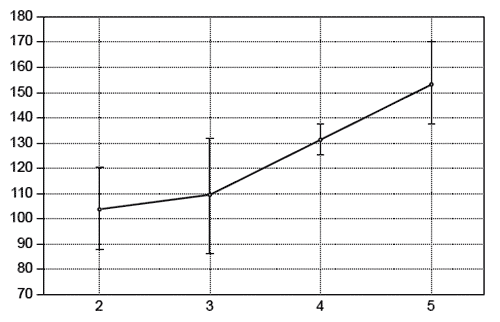
Figure 1. Analysis of variance (ANOVA) results. The dependent variable was the achievement motivation questionnaire outcome, and the independent variable was the individual profile asymmetry (4 levels: 2-left partial, 3-equipartition, 4-right partial, and 5-right profile).
The individual asymmetry profile analyses revealed that the most common profile was the right partial profile (n=16), followed by the right profile (n=5), ambidextrous profile (n=5), and left partial profile (n=4). No subjects with the left profile were identified. The achievement motivation was found to higher in the participants with right dominant lateral organization profiles. The participants with right lateral profiles exhibited an average achievement motivation value of 154 ± 2,8 points, those partial right lateral profiles averaged 131.31 ± 11,5 points, those with ambidextrous profiles averaged 109 ± 5.1 points, and those with left partial lateral profiles averaged 104 ± 5.6 points.
We used analysis of variance (ANOVA) to study the influence of individual profile asymmetry (four levels: 2-left partial profile, 3-partial balanced (equipartitions), 4-right partial profile, 5-right profile) on achievement motivation. A significant effect was observed (F=8.4**, p< 0.01). The greatest of achievement motivation values were associated with greater expressions of the right features in the lateral organization profiles (Figure 1).
Psychodiagnostic results
Spearman correlation analyses of the associations between the diagnoses of temperament and achievement motivation revealed that achievement motivation was significantly and directly related to Sensitivity to Sensations (SS, r=0.43, p<0.05), Intellectual Ergonicity (ERI, r=0.45, p<0.05), and Sensitivity to Probabilities (PRO, r=0.41, p<0.05).
Achievement motivation was inversely related to Impulsivity (IMP, r=–0.31, p<0.05) and Neuroticism (NEU) r=–0.62, p<0.05.
Figure 2 demonstrates the results of an analysis of variance (ANOVA) (dependent variable: the Sensitivity to Sensations (SS) scale; independent variable: achievement motivation). Figure 2 shows that the highest values on the Sensitivity to Sensations scale were observed for the students who were motivated by strong desires to succeed.
Type of motivation: OLS means
Wilks Lambda = .40020; F(22, 92)=2.4286; p=.00173
Vertical lines represent 0.95 confidence intervals
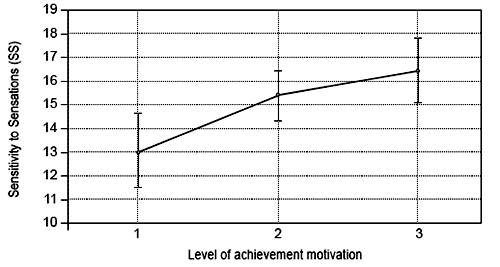
Figure 2. Analysis of variance (ANOVA) results (dependent variable: Sensitivity to Sensations
(SS) from the STQ-77R; independent variable: achievement motivation with 3 levels: 1 — motivation to avoid avoiding failure,
2 — medium level of achievement motivation, and
3 — motivation to succeed).
Figure 3 shows the results of an analysis of variance (ANOVA, dependent variable: the Intellectual Ergonicity (ERI) scale of the STQ-77R; independent variable: achievement motivation). Figure 3 shows that the highest values on the Intellectual Ergonicity scale were observed among the students who were motivated by a strong desire to succeed.
Type of motivation: OLS means
Wilks Lambda = .40020; F(22, 92)=2.4286; p=.00173
Vertical lines represent 0.95 confidence intervals
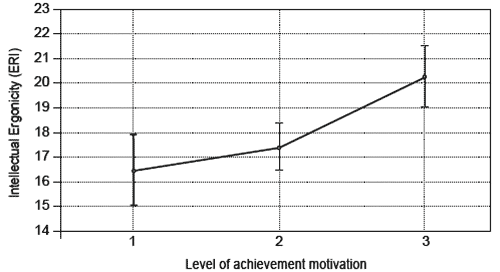
Figure 3. Results of a univariate analysis of variance (ANOVA, dependent variable: the Intellectual Ergonicity (ERI) scale of the STQ-77R; independent variable: achievement motivation with 3 levels: 1 — motivation to avoid failure, 2 — medium level of achievement motivation, 3 — motivation to succeed).
Type of motivation: OLS means
Wilks Lambda = .40020; F(22, 92)=2.4286; p=.00173
Vertical lines represent 0.95 confidence intervals
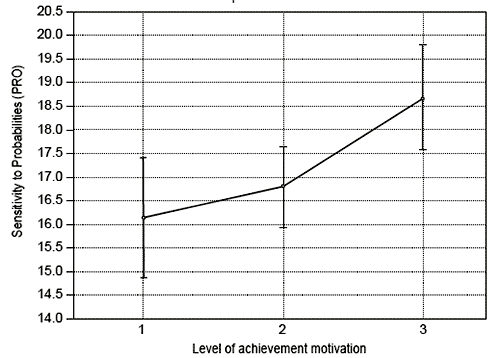
Figure 4. Results of a univariate analysis of variance (ANOVA) (dependent variable: the Sensitivity to Probabilities (PRO) scale of the STQ-77R; independent variable: achievement motivation with 3 levels: 1 — motivation to avoid failure, 2 — medium level of achievement motivation, 3 — motivation to succeed).
Figure 4 shows the results of a univariate analysis of variance (ANOVA) (dependent variable: the Sensitivity to Probabilities (PRO) scale of STQ-77R; independent variable: achievement motivation). Figure 4 shows that the highest Sensitivity to Probabilities values were observed among the students who were motivated by a strong desire to succeed.
Type of motivation: OLS means
Wilks Lambda = .40020; F(22, 92)=2.4286; p=.00173
Vertical lines represent 0.95 confidence intervals
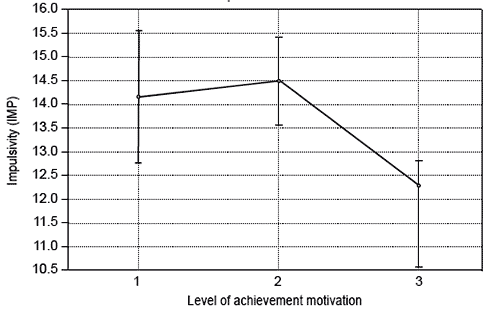
Figure 5. Results of a univariate analysis of variance (ANOVA) (dependent variable: the Impulsivity (IMP) scale of the STQ-77R; independent variable: achievement motivation with 3 levels: 1 — motivation to avoid failure, 2 — medium level of achievement motivation, 3 — motivation to succeed).
Type of motivation: OLS means
Wilks Lambda = .40020; F(22, 92)=2.4286; p=.00173
Vertical lines represent 0.95 confidence intervals
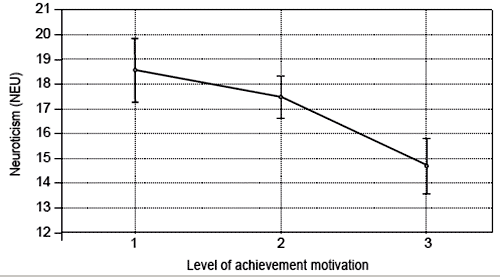
Figure 6. Results of a univariate analysis of variance (ANOVA) (dependent variable: the Neuroticism (NEU) scale of STQ-77R; independent variable: achievement motivation with 3 levels: 1- motivation to avoid failure, 2 - medium level of achievement motivation, 3 - motivation to succeed).
Figure 5 shows the results of a univariate analysis of variance (ANOVA) (dependent variable: the Impulsivity (IMP) scale of the STQ-77R; independent variable: achievement motivation). Figure 5 shows that the highest values on the impulsivity scale were observed among the students who were motivated by a strong desire to avoid failure and those with a medium level of achievement motivation.
Figure 6 shows the results of a univariate analysis of variance (ANOVA) (dependent variable: Neuroticism (NEU) on the STQ-77R; independent variable: achievement motivation). Figure 6 shows that the highest values on the neuroticism scale were obtained from the students with a strong motivation to avoid failure.
Thus, the results of the study showed that psychology students with strong motivations to succeed scored highly on the Sensitivity to Sensations, Intellectual Ergonicity, and Sensitivity to Probabilities scales, and these students exhibited low scores on the Impulsivity and Neuroticism scales.
Conclusion
This paper found that people with a strong motivation to succeed exhibit predominantly right features in their lateral organization profiles. Their cardiovascular systems are in more activated states than those of people who are extensively motivated to avoid failure. In this case, the lower alpha index values during the test situation when the participants’ eyes were open can be regarded as evidence of greater activation of the brain systems responsible for self-regulation and attention.
It has been shown that increases in heart rate variability are observed simultaneously with decreases in α power and are indicative of enhancements of activation (Yu X. et al., 2009, Chang et al., 2011).
The close relationship of the indices of α activity and heart rate variability has also been shown, and this relationship testifies to the important role of neurovisceral relationships in the regulation of mental processes (Bazanova et al., 2013).
In the present study, we found that among psychology students, the focus on achieving success was associated with low impulsivity. Egorova MS and colleagues suggested that achievement motivation can be considered to be a component of the basic properties of an individual (similar to the “Big Five” personality traits of awareness and impulse control) (Egorova et al., 2004).
Moreover, the psychology students with high levels of motivation to succeed also exhibited high levels of Intellectual Ergonicity and Sensitivity to Probabilities (i.e., the ability to quickly predict events and predict their consequences). In our opinion, this result is due to the specific professional work of psychologists.
In this study of the temperament features of psychology students with different levels of achievement motivation, the level of achievement motivation was found to be related to the properties of temperament such that lower levels of achievement motivation (i.e., the motivation to avoid failure) corresponded with the temperament traits of Neuroticism and Impulsivity and with low values on the Sensitivity to Sensations, Intellectual Ergonicity, and Sensitivity to Probabilities scales among psychology students.
high levels of achievement motivation (i.e., the motivation to striving for success) corresponded with the high scores on the Sensitivity to Sensations, Intellectual Ergonicity, and Sensitivity to Probabilities scales and low scores on the Impulsivity and Neuroticism scales.
Acknowledgements
This study was funded by The Ministry of Education and Science of the Russian Federation, grant no 25.2141.2014/K.
References
Bazanova, O. M., Balioz, N. V., Muravleva, K. B., & Skoraya M. V. (2013). Effect of Voluntary EEG α Power Increase Training on heart Rate Variability. Human Physiology, 39(1), 86–97. doi: 10.1134/S0362119712060035
Boomsma, D. I. (2009). Geneticinfluencesonhandedness: Datafrom 25,732 Australianand Dutch twin families. Neuropsychologia, 47, 330–337. doi: 10.1016/j.neuropsychologia.2008.09.005
Chang, L. J., Lin, J. F., & Lin, C. F. (2011). Effect of Body Position on Bilateral EEG Alterations and Their Relationship with Autonomic Nervous Modulation in Normal Subjects. Neuroscience Letters, 490(2), 96. doi: 10.1016/j.neulet.2010.12.034
Egorova, M. S., Zyryanova, N. M., Parshikova, O. V., Pyankova, S. D., & Chertkova, Y. D. (2004), Genotype. Environment. Development. Moscow: OGI.
Ermakov, P. N., & Vorobjeva, E. V. (2010). Individualnaya profilnaya ssimmetriaya bliznecov I spektralnye harakteristiki EEG pri vypolnenii arifmeticheskih operaciy I verbalno-ssociativnoy deyatelnosti [Individual profile asymmetry at twins and EEG spectral characteristics at performance of the arithmetic account and verbally-associative activity]. Rossiyskiy Psikhologicheskiy Zhurnal [Russian psychological journal], 7(1), 8–24.
Ermakov, P. N., & Vorobyeva, E. V. (2011). Achievement motivation and EEG spectral power. Psychology in Russia: State of the Art, 4(1), 448–464. doi: 10.11621/pir.2011.0030
Ilyin, E.P. (2001) Differencialnaya psihofiziologiyay [Differential psychophysiology]. Saint Petersburg: Piter.
Novgorodova, J. O., Muhordova, O. E., Sivakova ,V. G., Lobaskova, M. M., Barsky, F. I., & Malykh, S. B. (2010). Geneticheskie I sredovye factory v formirovanii individyalnyh osobennostey temperamenta u detey mladshego shkolnogo vozrasta [Genetic and environmental factors in the formation of the individual characteristics of temperament in children of primary school age]. Theoretical and experimental psychology, 3(4), 5–19.
Medland, S. E., Duffy, D. L., Wright, M. J., Geffen, G. M., hay, D. A., Levy, F., Van-Beijsterveldt, C. E. M., Willemsen, G., Townsend, G. C., White, V., hewitt, A. W., Mackey, D. A., Bailey, J. M., Slutske, W. S., Nyholt, D. R., Treloar, S. A., Martin, N. G., & Boomsma, D. I. (2009). Genetic influences on handedness: data from 25,732 Australian and Ditch twin families. Neuropsychologia, 47(2), 330–337. doi: 10.1016/j.neuropsychologia.2008.09.005
Sommer, I. E., Aleman, A., Somers, M., Boks, M. P., & Kahn, R. S. (2008). Sex differences in handedness, asymmetry of the Planum Temporale and functional language lateralization, Brain research, 1206, 76–88. doi: 10.1016/j.brainres.2008.01.003
Rusalov, V. M., Rusalova, M. N., & Strelnikova, E. V. (2004). Svyaz harakteristik EEG s dominirovaniem motivov dostizeniyay celi v processe vypolneniya zadach [Communication characteristics of EEG with the dominance of the motives of achievement in carrying out the tasks]. Phisiologiya Cheloveka [Human Physiology], 30(3), 13–19.
Rusalov, V. M., & Trofimova, I. N. (2011). O predstavlennosti tipov psihicheskoy deyatelnosti v razlichnyh modelyah temperamenta [On the representation of types of mental activity in various models of temperament]. Psilhologicheskiy Zhurnal [Psychological Journal], 3, 74–84.
Malykh, S. B., Gindina, E. D., & Nadyseva, V. V. (2009). Genetic and environmental influences on temperament in adolescence. Psychology in Russia: State of the Art, 2, 361–384. doi: 10.11621/pir.2009.0018
Teixeira, L. A. (2008). Categories of manual asymmetry and their variation with advancing age. Сortex,44, 707–716.
Vorobyeva, E. (2012). EEG spectral power and individual profile asymmetry of twins. International journal of psychology, 47(1), 146.
Vorobyeva, E. V. (2006). Psichogeneticheskoe issledovanie vzaimosvyazi temperamenta I motivacii dostizeniy [Behavioral genetics research of the relationship between temperament and achievement motivation]. Izvestija vuzov. Severo-Kavkazskijregion. Sotsialniye Nauki [News of higher educational institutions.The North Caucasusregion. Social Sciences], 3, 110–111.
Vorobyeva, E., & Ermakov, P. (2012). Event-related potentials and achievement motivation (research of twins). International Journal of Psychophysiology, 85(3), 421. doi: 10.1016/j. ijpsycho.2012.07.149
Vorobyeva, E. V., & Popova, V. A. (2009). Issledovanie intellekta i motivacii dostizhenija bliznecov [The study of intelligence and achievement motivation of twins]. Rossijskij psihologicheskij zhurnal [Russian psychological journal], 6(1), 46–53.
Vuoksimaa, E., Koskenvuoa, M., Rosea, R. J., & Kaprioa, J. (2009). Origins of handedness: A nationwide study of 30 161 adults. Neuropsychologia, 47, 1294–1301. doi: 10.1016/j. Neuropsychologia. 2009.01.007
Yuriev, G. P., & Skomorokhov, A. A. (2007). Primenenie egoskopa [The use of “Egoskop“]. BOS. Best of Security, 14, 72-74.
Yu, X., Zhang, J., & Xie, D. (2009). Relationship between Scalp Potential and Autonomic Nervous Activity during a Mental Arithmetic Task. Autonomic Neuroscience, 146(1–2), 81. doi: 10.1016/j.autneu.2008.12.005
To cite this article: Vorobyeva E.V., Ermakov P.N., Saakyan O.S. (2015). The relationships between the achievement motivations and temperaments of psychology students with different lateral organization profiles. Psychology in Russia: State of the Art, 8(1), 32-42.
The journal content is licensed with CC BY-NC “Attribution-NonCommercial” Creative Commons license.










